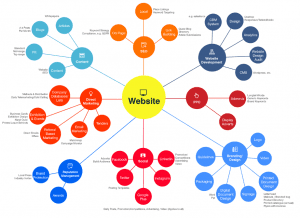-
8 Marketing Strategies for Small Business Websites
Looking for marketing strategies for small business websites? If so, then you are in the right place. From giving you tips on how to get your website in first place with Google Rankings, to animated logos and Instagram, this article will get you thinking creatively about how you can utilise your marketing tactics to succeed in your industry.
1. SEO
–
Search Engine Optimisation is a term commonly thrown around in the marketing world, and for good reason. It is perhaps one of the most important aspects to take into account when trying to extend your brand reach and attract a wider audience. Build links within local and wider directories and offer up guest blogs to appear on relevant websites within your industry. Through spreading your knowledge and company name, you can attract more traffic towards your website and hopefully gain new clients.
2. Socials
–
In an age of social media it is no wonder that it is also a significant tool in marketing your brand. Statistics matter; the more followers you have, the more potential and existing clients you have. It doesn’t end here though. Don’t just build your audience, engage with them. Post regularly and be active; comment on feeds, like photos, retweet relevant posts, join Facebook groups and spread your brand reach throughout a variety of platforms. Consider running competitions, promotions, free live webinars and Q&A sessions and you can widen your network even further.
3. PPC
–
Your use of keywords can provide huge potential for gaining new customers. Apply those high-ranking keywords and knock your competitors down the list whilst you push yourself up to first place on Google search.
Ads and AdWords can help you to not only build your audience, but to target the right demographic. Advertise not only key search terms associated with your business, but also your brand name. You don’t want your competitors paying for an advertisement to appear above you on your own brand name search! Set up Google Ads and use Google keyword planner to make a plan of action and ensure you appear at the top. This can then be a starting point from which to build a natural listing on your brand name.
4. Content
–
Your content is a key marketing strategy for your website. Try to write a certain number of blogs for your page every month, as well as articles, whitepapers, videos and proposals. Your website resource page should be consistent and enticing, whilst also being SEO-friendly and including those ever-important keywords.
Have a look at our Insights page to give you some ideas.
5. Branding and Design
–
A key strategy to attracting more traffic is boosting your website design. Perhaps consider developing an animated logo or an illustrated video to rejuvenate your brand identity and capture attention. Look into creating unique and personalised packaging that encapsulates your business’ vision and sets you apart from your competitors.
Have a look at our animated logo reel and get in contact for some design ideas.
Have a look at one of our event illustrative videos and get in contact for further information.
6. Direct Marketing
–
Get your brand name out there! Send out emails on Campaign Monitor, create Tenders, utilise daily telemarketing, go to exhibitions and events and give out business cards and hand-outs. Direct marketing will help you enhance brand awareness and expand your brand reach to a wider potential client base.
Have a look at CRM websites such as HubSpot to assist in attracting customers, converting leads and closing customers through allowing your marketing and sales departments to manage their activities in one place.
7. Website Development
–
User experience plays a huge role in enhancing your business’ website. From desktop responsiveness to website speed, these can affect your website’s bounce rate and a user’s overall experience and likelihood to use and recommend your brand. You can even include a call-to-action, such as ‘free trial’ or ‘book a demo’ to further encourage new clients.
Tools, such as an online chat widget can also assist in immediate enquiries and is a valued instrument in buyer decision making. Furthermore, including website statistics that shed light on your company’s successes can add to buying confidence.
You can also use analytics and tracking as important research tools to understand and optimise web usage, so that you can continually assess and improve the effectiveness of your website.
8. Reputation Management
–
Brand protection is a necessity when considering your marketing strategies. Connect with local databases in the area, such as the local press and local businesses, as well as within the wider industry news.
Make clear any awards your brand has received and enhance the trust in your business. You can also do this through advertising your trusted reviews and thus boosting consumer confidence. Both of these marketing tactics will allow you to retain your current clients, but also gain new ones.
In short, incorporate these 8 strategies into your marketing approach and you will soon begin to reap the benefits!
Details:
Written by Octavia on behalf of ClearBrand, October 2020.
To get in contact about working with ClearBrand on a project,
please call +44 (0)118 959 9284 or email info@clearbrand.co.uk.



